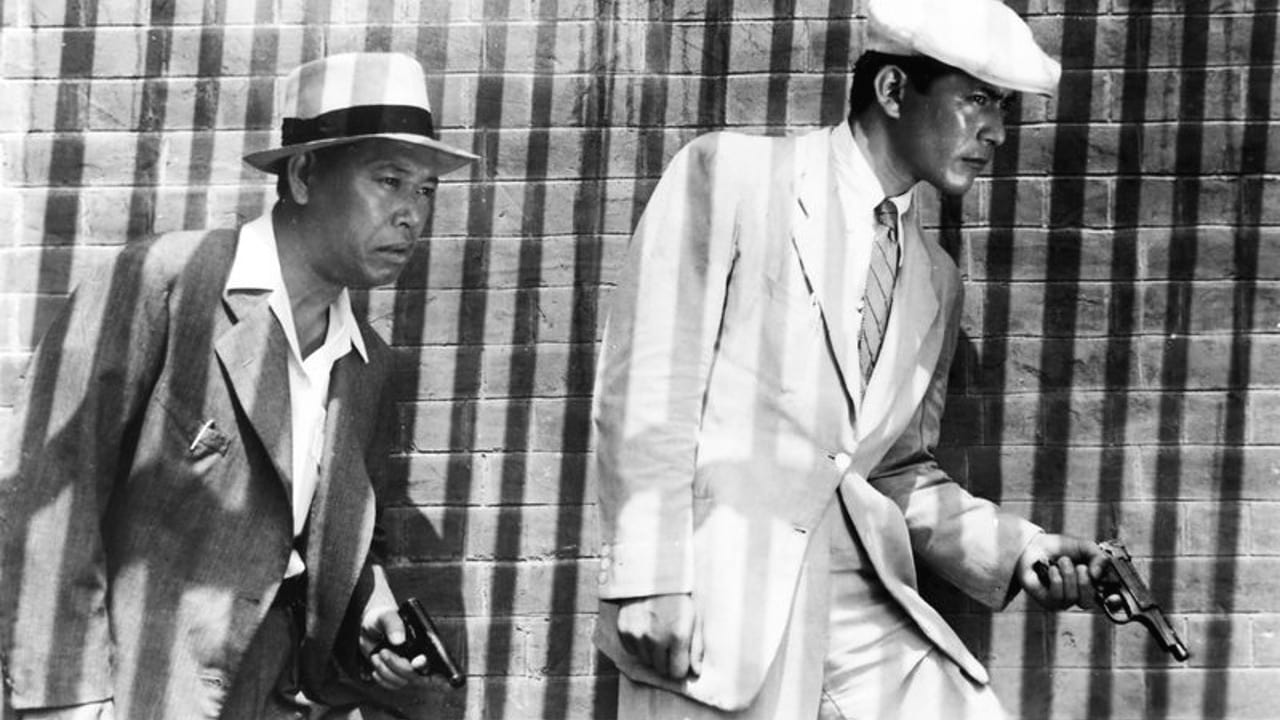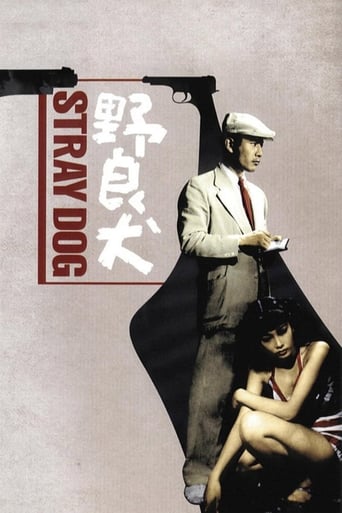

A rookie police detective has his service pistol stolen. He sets off to find the thief, unravelling a complex web of criminals in the process.A earlyish-career movie from the famed Akira Kurosawa, and it shows, to an extent. Long-winded, with scenes that seem to exist only to take up space. The soldier scenes and baseball scenes are good examples - seem to go on forever and don't add much. The plot seems complex just for complexity's sake - the case was simpler than the movie made out. This said, there is a decent amount of intrigue and Kurosawa does build the tension well. Just a pity editing and dynamism weren't priorities.
... View MoreRookie detective Toshiro Mifune (Murakami) gets his gun pick-pocketed and embarks upon a journey to retrieve it. He starts out alone but eventually teams up with a wiser cop played by Takashi Shimura (Sato). All the while, his gun is being used in more and more deadly crimes and his sense of shame and dishonour drives him onwards to rectify the situation. The gun has seven bullets, and by the end of the film, all of them have been fired.Director Akira Kurosawa delivers a high quality effort in capturing a tense atmosphere and stifling Tokyo heat. The characters are entertaining and the dialogue realistic with some memorable scenes, eg, the chorus of girls dancing in the nightclub and then running backstage to relax - this is where we first encounter Keiko Awaji (Harumi Namaki), who has a significant role as the killer's girlfriend. We are led to believe that Mifune has many similarities with the killer Isao Kimura (Yusa) – they have just chosen different paths.I must mention the dialogue - one particular gem is the moment when a woman's emotional behaviour is very frankly put down to her being on her period. How true. Hollywood just wouldn't dare.The film draws you in from the start, although it's overall length could be shortened. There is one scene which is a montage of shots of Mifune wandering around the shady districts of Tokyo. Whilst the accompanying music to this is interesting, we get the point after a couple of minutes. There are a few sections like this where the director drags it out a little too long. A good film. No-one has mentioned this yet but is it significant that Mifune doesn't actually speak his dialogue - he barks it like a dog?
... View MoreIt has always amazed me that Akira Kurosawa managed to adapt to any kind of genre with such incredible ease, every time attracting the attention of the whole world. As one might have expected, it's also happened in the case of Stray Dog. Although the picture is greatly influenced by the western noir genre and it looks but that way, it clearly possess this mesmerizing Japanese touch, making it even more astounding and provoking than many classic American crime pictures. It's a great detective story with a lot of sudden twists and turns in the thrilling story. What's fascinating about Stray Dog is the fact that it starts with such a seemingly trivial matter like a stolen gun, but proceeds to develop a mostly riveting intrigue filled with unnecessary murder and deep obsession.The storyline closely follows Detective Murakami (Toshiro Mifune) who – along with Detective Sato (Takashi Shimura) – embarks on a dangerous journey in order to find his precious Colt. With every discovery the story becomes more complicated and sombre. One dead body leads to another. As the film gradually changes its tone and intensifies the pace, it also creates a mightily mystic and overwhelmingly suspenseful atmosphere. When the mood alternates, the murky cinematography begins to uncover a darker side of the picture. It's fascinating how – through slow movement and ubiquitous sweat trickling down the characters' bodies – Kurosawa pictured the tremendous heat that permeates every scene. What's more, through the contradiction of two differing viewpoints – that of a young cop and that of an older cop – the film alternates between two contrasting perceptions of the events and doesn't clarify which one of them is valid.This is yet another amazing collaboration between Kurosawa and Toshiro Mifune. Every picture they filmed together turned out to be a huge hit, and Stray Dog only confirms the trend. Mifune plays an emotional and inexperienced detective who is at first more concerned about his beloved gun than about other people's lives. On the opposite side there is Takashi Shimura, who gives a marvelous performance as Murakami's likable and enormously calm acquaintance Sato, who tends to rely on his intuition and not on his feelings. And as the two characters bond, Sato tries to teach his companion the old-fashioned yet perfectly plausible rule – don't sympathize with the suspects, as you might become too weak and unable to fulfill your duties as a policeman.Through this thrilling tale of mystery and murder Kurosawa was also able to show his personal view on the tough situation in post-war Japan. It's his auteur take on the struggling middle class, its members, and the crimes that those people have to commit in order to make ends meet. All the brutality, inhumanity and deception presented in this movie are caused mainly by the inequality in Japanese society. Apart from creating a visually stunning masterpiece and a truly compelling detective story, Kurosawa also skillfully persuaded the audience that behind most violent acts hides a purpose, even when it all seems like the work of a titular stray dog. Still, ironically so, those terrifying creatures have to suppress their urges as well, but with every subsequent act of violence their hunger and anger rise to the level of murder. And that's definitely too hard for the protagonists too grasp.
... View MoreI wish everybody who thinks owning a handgun is unqualified as a right and trivial as a responsibility would watch this film, in which Toshiro Mifune, a cop, gets his Colt stolen on a streetcar and spends the rest of the movie trying to get it back. First it falls into the hands of an illicit gun dealer who rents it out (in return for a ration card) for a crime that a first-time criminal doesn't have the nerve to commit. When the dealer is busted and the gun fortuitously remains in the hands of the failed criminal, a robbery is committed with it, and then a robbery/murder. Turns out the criminal is of the same generation as Mifune, a veteran like Mifune, and they have simply taken different paths in the squalor and chaos (meticulously depicted) of postwar Japan.Mifune ends up seconding a wily veteran cop on the case (Takashi Shimura, who played Mifune's doctor/mentor in the star's first film for Kurosawa, "Drunken Angel"), and a series of mounting climaxes follows. The entire story happens to take place in the middle of a cruel and universally demoralizing heat wave, punctuated at times by heavy but ineffectual rainstorms.Has there ever been a more charismatic movie star than Mifune? First of all, he's beautiful here, in the almost gaunt style of the very early Gregory Peck, but he also has the idiomatic look of a samurai on a painted screen, his features uncannily reproducing a classical style of art, and his eyebrows arching in a way we've seen a thousand times in art but rarely in life.And his acting is so laceratingly felt and real. This is one of those times when a sensibility profoundly Japanese (the young cop's sense of personal responsibility and shame) figures in a Kurosawa film, and yet we westerners are able to identify strongly with it -- even as Shimura and the partners' superiors act as voices of reason and experience, and tell Mifune at every turn that it's useless, no matter what the circumstances, to blame anyone but the fugitive.The gun had seven bullets when it was stolen, and the movie makes Mifune (and us) conscious of the remaining number after each occasion the gun is used. The breathless climax of the film -- a chase and a final duel -- begins with three bullets still in the shooter's clip and Mifune unarmed. Kurosawa makes us feel something for everybody. A hardened female pickpocket turns out to have a humane side. A gun-dealer's moll basically has the mind of a child, and Shimura is able to ingratiate himself with a judicious use of popsicles and cigarettes. The first victim (whom we never meet) is a woman whose dowry is stolen after she has waited 10 years to accumulate enough to marry. The second victim is a beautiful newlywed, whose devastated husband then smashes her tomato plants for the offense of being alive, and ripe.And by the time we meet the shooter, we feel we know him. We never do hear him speak, but all through the last few climactic minutes we are in both his head and Mifune's. The whole movie has been spiritually and physically oppressive on all the characters, and the final sequence literally exhausts the pursuer, the pursued, and the audience. Then there comes a quiet epilogue between the two cops in a hospital room, to let us collect ourselves. What a good movie!
... View More